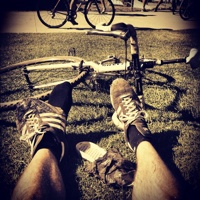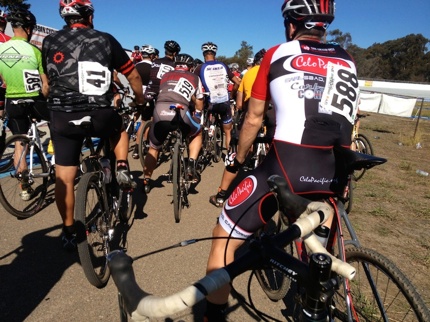I’m a terrible spectator.
I just can’t do it. I can’t be interested in something if I’m not actually doing it. Just can’t. This often puts me in awkward situations, because lots of things are probably fine to watch and not participate in, particularly for middle agers like me. But maybe I’m not your typical middle ager. Rather, I’m the one 44-year-old on a field of 20-somethings at the Sunday pick-up soccer game, or at the skatepark with a swarm of tweens zipping all around me. And when I say awkward, I mean for them. Because—after all—I’m used to the looks, the shrugs, the questions. It’s everyone else who’s crazy.
I think I’m just comfortable around weirdos (that would sure explain a lot). In fact, I gravitate toward them. You’d think that as I settle into middle age I’d be content with all the work, family, hobbies, and clutter I’ve accumulated in almost a half century of accumulating, but such is not my nature. Every so often, my mind latches onto something new, and I investigate, and sometimes exhaust my interest in it; I’m pretty picky these days, I don’t just hop onto every cool thing I come across (that Stratos jump was pretty neat, but I don’t plan to become a human rocket anytime soon).A couple years ago I took up road biking, not out of any desire to compete or race, but initially as an alternative to running (as most 40-somethings will tell you, the knees go first). And in addition to riding, I’ve formed an addiction to building old bikes. I mostly ride a 1982 Peugeot PF 60 that I’ve assembled from period parts, but have also built a 1970s Jeunet townie, an 80s Gitane commuter, an early 90s Vitus single-speed, etc. (you might have noticed by now that I have a thing for old, French, and lugged). It starts with a frame, and part-by-part just happens. If you’ve been there, you know.
 I love riding, but I’m not a natural competitor. So, watching the Tour last Summer didn’t mean I had to go out and chase down Wiggo. Putting miles on my Peugeot, solo, was sufficient. I was content to cruise in my own private peloton.
I love riding, but I’m not a natural competitor. So, watching the Tour last Summer didn’t mean I had to go out and chase down Wiggo. Putting miles on my Peugeot, solo, was sufficient. I was content to cruise in my own private peloton.
Then I came across some cyclocross videos online. It wasn’t just interesting, I found myself infatuated with it. Dirt, gravel, sand, mud … and on foot? Up stairs, over barriers, across lakes of muddy brine. WTF?!
I mean, seriously, who’s riding whom? At first I thought it was some contrived energy-drink-sponsored prank. No self-respecting cyclist would ever do that to their bike (let alone to themselves … but then, cyclists are a masochistic bunch, right?). Even so, they love their bikes. They fawn over their bikes. They would never treat their bikes like that.
Or would they?
That was the question that intrigued me, and an answer I soon realized was true. It’s real, this cyclocross thing. Or rather, its ALIVE!
Which meant that I crossed the line (no pun intended), and I now had to find a way to actually do it. How does one do something like that? I may as well have decided to take up bobsledding.
When I first built a road bike and began that pursuit, it was pretty straightforward (if you’ve ever been on a cross course, you know there is nothing straightforward about it). So there I was, flying down the boulevard on my rebuilt lugged Peugeot. And over time, I practiced, paid attention, asked way too many questions at my LBS, and have been exploring the major and minor routes throughout San Diego County ever since. If you ease into it, I found, you slowly refine your technique, ability to avoid automobiles, and etiquette with other cyclists. And to-date I haven’t been in or even caused a major accident (that I know of).
But road riding is one thing. Cyclocross is quite another. Road racers are a serious bunch. They’re disciplined and stick to grueling and extended training regimens. They eat everything they should, and nothing they should not. They train and train and train. Then they train some more. They store stats and calorie counts and revolutions per minute and other numbers in their computerized brains. And for some reason they still need another computer on their handlebars. Road racing is gnarly. So I just stuck to riding.
And then there’s cross. It’s serious, but not much. It’s competitive, but not much. And it’s way too complex to really understand just by watching. Which, we’ve established, I’m not very good at, anyway. So when I saw a cross race coming to San Diego (my hometown), my path was clear. My time had come. I would, at last, indulge in my new obsession.
One of my introductions to cyclocross was the YouTube video “An Hour In Hell,” which documents cross culture in Oregon. I should have taken the title of that piece at face value. But I didn’t. I should also have taken note of the message conveyed in just about every other cross video I watched—that it’s a mentally challenging and physically punishing endeavor. Mostly the latter. But I had convinced myself that I was fit for cross, and that I could handle a few laps around the “glorified BMX track.”
Idiot.
Southern California Cyclocross (SoCal Cross) held its Prestige Series San Diego CX event at the Velodrome in October. And (they would soon regret) this former spectator would realize his chance to—um—cross over into the realm of participant. I just couldn’t resist.
SoCal Cross embraces newbies (even the ones who show up early to badger staff with too many questions). They run youth events, they encourage people of all abilities to get out on the course. They even host beginner clinics, and everyone is welcome. Even, apparently, me.
So I signed up to take the class, of course. I had watched all of Kris Westwood’s and Mickey Denoncourt’s instructional videos on YouTube, so the class would be just a review of what I already knew.
Idiot.
I actually did pretty well. The instructor told me I was good at dismounting and re-mounting the bike through the barrier section. It boosted my confidence. And fortunately, I think, I got a little cocky during a practice run. Which, in cross, is exactly when karma swoops down and slaps you square in the face—in other words, I ate shit. I made the mistake of admiring my wheel through a turn (breaking rule number one: Keep your eye on where you’re going, not on where you are), and found myself in the dirt, with my bike in a similar pile right behind me. Well, their bike (I rented it from SoCal Cross).
One aspect of cross I came to love early on is that it’s not about how much shit you eat, it’s how you recover. So off I went, back in the saddle. I made it through the rest of the course and back to the staging area just in time for the start. At first I thought I had held up the race, given the way everyone was looking at me. Then I realized I was the only person in the group with cargo shorts, platform pedals, sneakers, and an iPhone. Had a few seconds to check e-mail and snap a group photo of my new best buds. So why not?
Over the next 40 minutes I came to realize a few things. First was that they weren’t my new best buds. From the start, no matter how frantically I pedaled, they seemed to just flow away from me. Eventually, several of them would come up from behind and say things like, “On your left! … Your other left!” I have a poor sense of direction.
I also realized that the second lap of a cross race is probably the worst. Your heart rate isn’t quite there yet, you’re sucking wind, and you still have most of the race ahead of you. The fourth lap is the best because you’re well into your second wind, and you can smell the finish line. Or maybe that’s just the dust from the peloton that just lapped you.
 On lap four, the importance of proper footwear also became brutally apparent as my adidas Sambas exploded through a turn, forcing me to finish the race with the duct-taped outsole dangling like a flip flop.
On lap four, the importance of proper footwear also became brutally apparent as my adidas Sambas exploded through a turn, forcing me to finish the race with the duct-taped outsole dangling like a flip flop.
Crossing the finish line was truly a victory. I was dead last (of those who actually finished the race), but my goal that day was simply to complete it. I’ll leave competing as a goal for future races. I contemplated that as I lay on the grass next to the technical section of the course, sucking clouds out of the sky, and trying desperately to keep my lungs from jettisoning with each heave.
It was then that one of my new best buds leaned over me and asked how I was. “Fine,” I struggled to say between breaths. He smiled and suggested I try the C class next time. The Mens 45+ B class I had just raced has some pretty advanced racers in it, and C is more of a Beginners field. “Duly noted,” I panted, and he wandered off.
Eventually I recovered, respiratory system intact, returned the bike, and took stock of my introduction to cyclocross. The pain, the struggle, the terrifying close calls with trees, ditches, walls, and other solid objects began to fade on the drive home. The sinking feeling you get when the entire group drops you right out of the start was dulled by the realization that those guys were going to lap me anyway (once, twice—maybe three times).
By the time I got home, all that was left were the sensation of rolling onto the course on a purpose-built bike, taking in the instruction I got, and reaching deep down to apply every once of strength, wit, and balance I could muster to complete the race. What was left was the realization that I left it all out on the course, and I lived to talk about it. And write about it.
When I walked in the house, my wife asked me how it went. “You’re looking at the new cyclocross champion,” I said, despite my last-place finish.
And she thought I was joking.
Miki Vuckovich is a lifelong skateboarder and soccer enthusiast, who originally took up road biking as an alternative to running. In November he rode in his second cyclocross race, this time in the Mens C class, finishing 34 of 35 riders.
